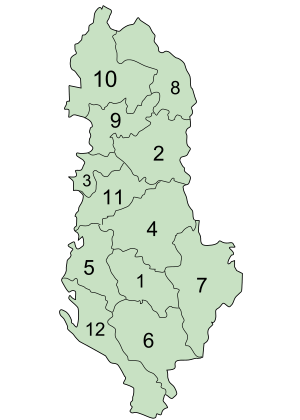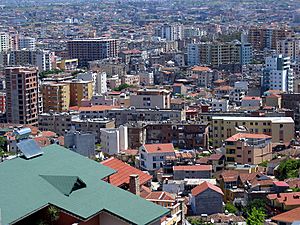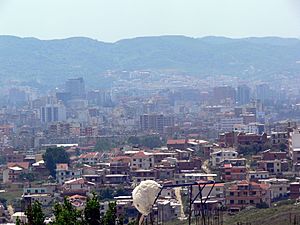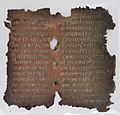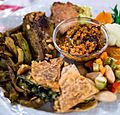Albania facts for kids
Quick facts for kids
Republic of Albania
Republika e Shqipërisë (Albanian)
|
|
|---|---|
|
Motto: Ti Shqipëri, më jep nder,
më jep emrin Shqipëtar "You Albania, give me honour, you give me the name Albanian" |
|
|
Anthem: "Himni i Flamurit"
"Hymn to the Flag" |
|

Location of Albania (green)
|
|
| Capital and largest city
|
Tirana 41°19′N 19°49′E / 41.317°N 19.817°E |
| Official languages | Albanian |
| Recognised minority languages | |
| Religion
(2023)
|
|
| Demonym(s) | Albanian |
| Government | Unitary parliamentary republic |
| Bajram Begaj | |
| Edi Rama | |
|
• Parliament Speaker
|
Elisa Spiropali |
| Legislature | Kuvendi |
| Establishment history | |
| 1190 | |
| February 1272 | |
| 1368 | |
| 2 March 1444 | |
|
• Pashalik of Scutari/Janina
|
1757/1787 |
|
• League of Prizren
|
10 June 1878 |
|
• Proclamation of independence from the Ottoman Empire
|
28 November 1912 |
|
• Principality of Albania
|
29 July 1913 |
|
• 1st Republic of Albania
|
31 January 1925 |
|
• Kingdom of Albania
|
1 September 1928 |
| 10 January 1946 | |
|
• 3rd Republic of Albania
|
28 December 1976 |
|
• 4th Republic of Albania
|
29 April 1991 |
| 28 November 1998 | |
| Area | |
|
• Total
|
28,748 km2 (11,100 sq mi) (140th) |
|
• Water (%)
|
4.7 |
| Population | |
|
• 2023 census
|
2,402,113 |
|
• Density
|
83.6/km2 (216.5/sq mi) |
| GDP (PPP) | 2024 estimate |
|
• Total
|
|
|
• Per capita
|
|
| GDP (nominal) | 2024 estimate |
|
• Total
|
|
|
• Per capita
|
|
| Gini (2019) | ▼ 34.3 medium |
| HDI (2022) | high · 74th |
| Currency | Lek (ALL) |
| Time zone | UTC+1 (CET) |
|
• Summer (DST)
|
UTC+2 (CEST) |
| Driving side | right |
| Calling code | +355 |
| ISO 3166 code | AL |
| Internet TLD | .al |
Albania, officially called the Republic of Albania, is an independent country in Southeastern Europe. It covers an area of about 28,748 square kilometers. The capital city is Tirana. Other important cities include Durrës, Elbasan, and Vlora. Over 3 million people live in Albania. Most Albanians are Muslims, with others being Eastern Orthodox and Roman Catholics.
Albania shares borders with Kosovo, Montenegro, Greece, and Macedonia. It has a coastline along the Adriatic Sea to the west and the Ionian Sea to the southwest. The official language is Albanian. The national anthem is Hymni i Flamurit.
Contents
History of Albania
In ancient times, Albania was the southern part of a region called Illyria during the Roman Empire. Later, in the Middle Ages, different foreign countries ruled the Albanians. These included the Byzantine Empire and the Venetian Empires.
During the 16th century, a national hero named Skanderberg led a fight against the Ottoman Empire's rule. After four centuries of Turkish control, Albania finally became an independent country in the 20th century.
In 1939, fascist Italy took over Albania. It was part of the Kingdom of Italy until 1943. After World War II, Albania became independent again. It was then under communist rule, led by Enver Hoxha until his death in 1985. Ramiz Alia took over and later became President. In 1992, Albania became a democracy again. Today, Albania has good relationships with the European Union and hopes to join it.
Albania's Regions
Albania is divided into 12 main areas called counties. These counties are further split into smaller areas like districts and municipalities.
Major Cities in Albania
Here is a list of the largest cities in Albania.
| Rank | City | 2001 Census | 2011 census |
|---|---|---|---|
| 1 | Tirana | 352,581 | 421,286 |
| 2 | Durrës | 113,465 | 115,550 |
| 3 | Vlorë | 85,180 | 79,948 |
| 4 | Elbasan | 95,554 | 79,810 |
| 5 | Shkodër | 85,798 | 74,876 |
| 6 | Fier | 56,297 | 57,198 |
| 7 | Korçë | 58,911 | 51,683 |
| 8 | Berat | 45,572 | 36,467 |
| 9 | Lushnjë | 38,336 | 31,424 |
| 10 | Kavajë | 28,149 | 20,312 |
Albanian Armed Forces
The Albanian Armed Forces were first created after Albania became independent in 1912. Albania has made its military smaller over the years. In 1988, there were 65,000 active troops, but by 2009, this number was reduced to 14,500. Today, the military mainly consists of a small number of aircraft and sea vessels.
Geography of Albania
Albania covers a total area of 28,748 square kilometers. Its coastline is about 476 kilometers long. This coastline stretches along the Adriatic Sea and the Ionian Sea. Along the coast, winters are mild and wet, while summers are warm, sunny, and quite dry.
About 70% of Albania is covered by mountains. The highest mountain in the country is Korab.
Albania shares its borders with Greece, the Republic of Macedonia, Montenegro, and Kosovo. Kosovo is a state that is not recognized by Serbia and some other countries. A short stretch of sea separates Albania from the far southeast of Italy.
Plants and Animals of Albania
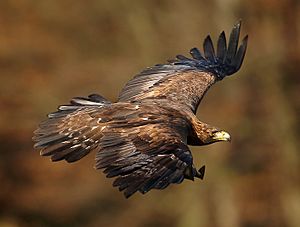
Even though Albania is a small country, it has a wide variety of plants and animals. There are over 3250 different types of plants. The country is home to more than 350 bird species, 330 kinds of freshwater and marine fish, and 80 mammal species. The Golden Eagle is a very important symbol for Albania and is its national animal.
Related pages
Images for kids
-
The remains of Kamenica Tumulus in the county of Korçë.
-
Founded in the 4th century BC, Scodra was a significant city of the Illyrian tribes of the Ardiaei and Labeates.
-
Apollonia was an important Ancient Greek colony on the Illyrian coast along the Adriatic Sea and one of the western points of the Via Egnatia route, that connected Rome and Constantinople.
-
The town of Krujë was the capital of the Principality of Arbanon in the Middle Ages.
-
Zog I was the first and only king of Albania; his reign lasted 11 years (1928–1939).
-
Enver Hoxha served as Prime Minister and First Secretary of the Party of Labour of Albania.
-
In 1988, the first foreigners were allowed to walk into the car-free Skanderbeg Square in Tirana.
-
The earthquake of November 2019 was the strongest to hit Albania in more than four decades.
-
Gjipe is located on the confluence of the Adriatic and Ionian Sea.
-
Panorma Bay on the Albanian Riviera in the south has a mediterranean climate.
-
The Albanian Alps in the north have a subarctic climate.
-
The golden eagle is the national symbol and animal of Albania.
-
The common bottlenose dolphin is a frequent visitor to the waters of the Albanian Adriatic and Ionian Sea Coasts.
-
The Lagoon of Karavasta within the Divjakë-Karavasta National Park is renowned for hosting the rare Dalmatian pelican.
-
Albanian soldiers in the Province of Kandahar, Afghanistan.
-
Tirana is the economic hub of the country. It is home to major domestic and foreign companies operating in the country.
-
Grapes in Berat. Due to the mediterranean climate, wine, olives and citrus fruits are mostly produced in Southern Albania.
-
Tirana International Airport is named in honour of the Albanian nun and missionary Mother Teresa.
-
The dialects of the Albanian language in Albania.
-
Representatives of the Sunni, Orthodox, Bektashi and Catholic Albanian communities and in Paris.
-
Butrint has been included in the UNESCO list of World Heritage Sites since 1992.
-
The Codices of Berat are eminently important for the global community and the development of ancient biblical, liturgical and hagiographical literature. In 2005, it was inscribed on the UNESCO's Memory of the World Register.
-
The Fortress of Bashtovë is on the tentative list for inscribing it as a UNESCO World Heritage Site.
-
Bukë misri (cornbread) is a staple on the Albanian table.
-
The former grounds of the headquarters of Radio Tirana in the capital of Tirana. Radio Televizioni Shqiptar (RTSH) was initially inaugurated as Radio Tirana in 1938 prior to the World War II.
-
Albanian iso-polyphony is designated as an UNESCO Masterpiece of the Oral and Intangible Heritage of Humanity.
-
Parashqevi Qiriazi - teacher and feminist (1880–1970)
See also
 In Spanish: Albania para niños
In Spanish: Albania para niños





